Detailed Examination: NSW Ambulance Service, Services, and Challenges
VerifiedAdded on 2019/11/26
|14
|2819
|417
Report
AI Summary
This report provides a comprehensive overview of the New South Wales Ambulance Service (NSWAS), examining its history, vision, objectives, and the diverse range of services it offers. The report delves into the specific services provided, including aero-medical, health emergency management, rapid response teams, rescue units, and special casualty access teams. It identifies the potential consumers of these services, primarily the population of New South Wales, and outlines the organization's contact information. The report also addresses the challenges faced by the NSWAS, such as adverse weather conditions, and the prospects for future development, including technological advancements and infrastructure improvements. Finally, the report highlights the impressive work of the NSW Ambulance Service and its role in ensuring public health and safety.

Running head: NEW SOUTH WALES AMBULANCE SERVICE
NEW SOUTH WALES AMBULANCE SERVICE
Name of the student:
Name of the university:
Author note:
NEW SOUTH WALES AMBULANCE SERVICE
Name of the student:
Name of the university:
Author note:
Paraphrase This Document
Need a fresh take? Get an instant paraphrase of this document with our AI Paraphraser
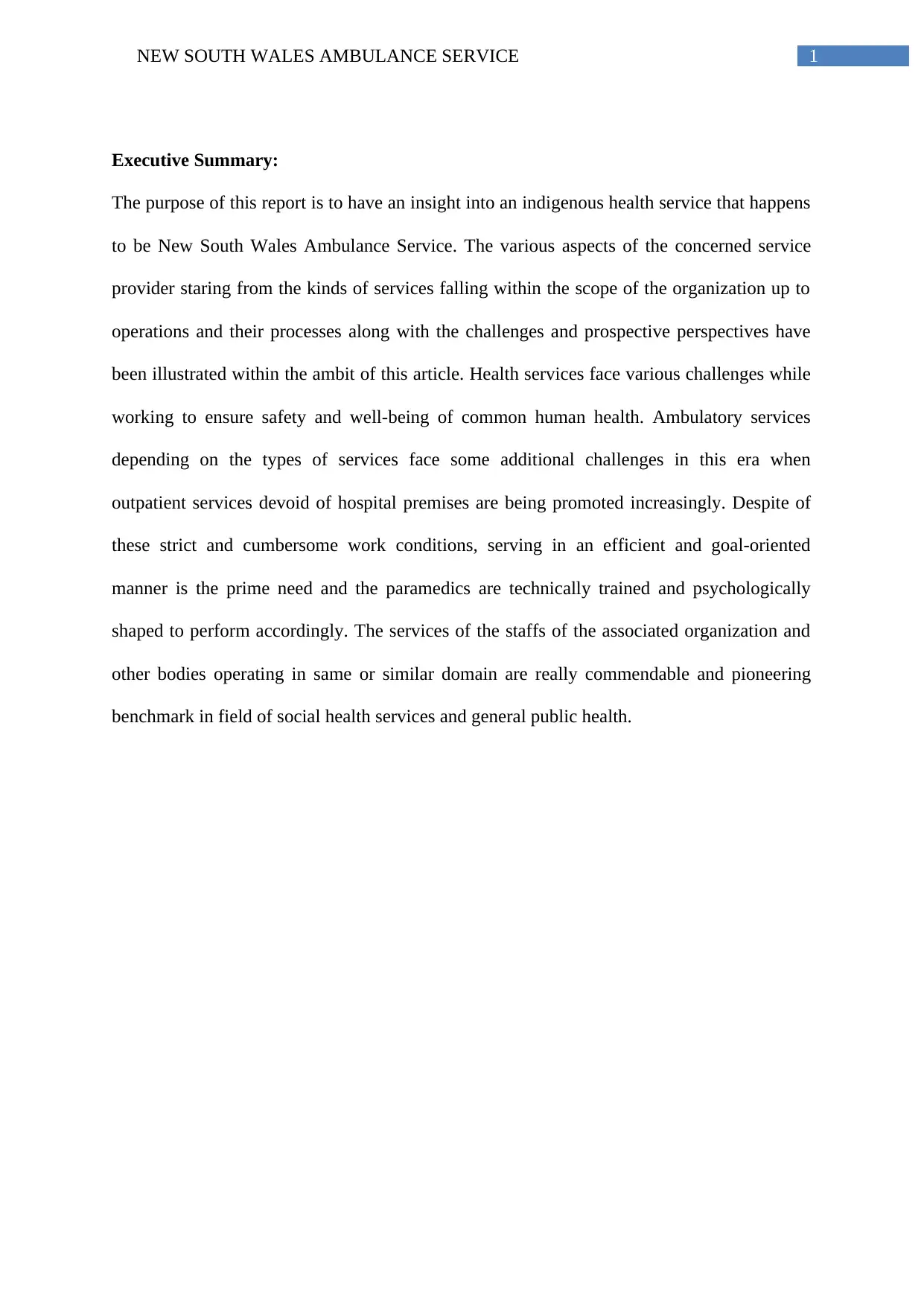
1NEW SOUTH WALES AMBULANCE SERVICE
Executive Summary:
The purpose of this report is to have an insight into an indigenous health service that happens
to be New South Wales Ambulance Service. The various aspects of the concerned service
provider staring from the kinds of services falling within the scope of the organization up to
operations and their processes along with the challenges and prospective perspectives have
been illustrated within the ambit of this article. Health services face various challenges while
working to ensure safety and well-being of common human health. Ambulatory services
depending on the types of services face some additional challenges in this era when
outpatient services devoid of hospital premises are being promoted increasingly. Despite of
these strict and cumbersome work conditions, serving in an efficient and goal-oriented
manner is the prime need and the paramedics are technically trained and psychologically
shaped to perform accordingly. The services of the staffs of the associated organization and
other bodies operating in same or similar domain are really commendable and pioneering
benchmark in field of social health services and general public health.
Executive Summary:
The purpose of this report is to have an insight into an indigenous health service that happens
to be New South Wales Ambulance Service. The various aspects of the concerned service
provider staring from the kinds of services falling within the scope of the organization up to
operations and their processes along with the challenges and prospective perspectives have
been illustrated within the ambit of this article. Health services face various challenges while
working to ensure safety and well-being of common human health. Ambulatory services
depending on the types of services face some additional challenges in this era when
outpatient services devoid of hospital premises are being promoted increasingly. Despite of
these strict and cumbersome work conditions, serving in an efficient and goal-oriented
manner is the prime need and the paramedics are technically trained and psychologically
shaped to perform accordingly. The services of the staffs of the associated organization and
other bodies operating in same or similar domain are really commendable and pioneering
benchmark in field of social health services and general public health.
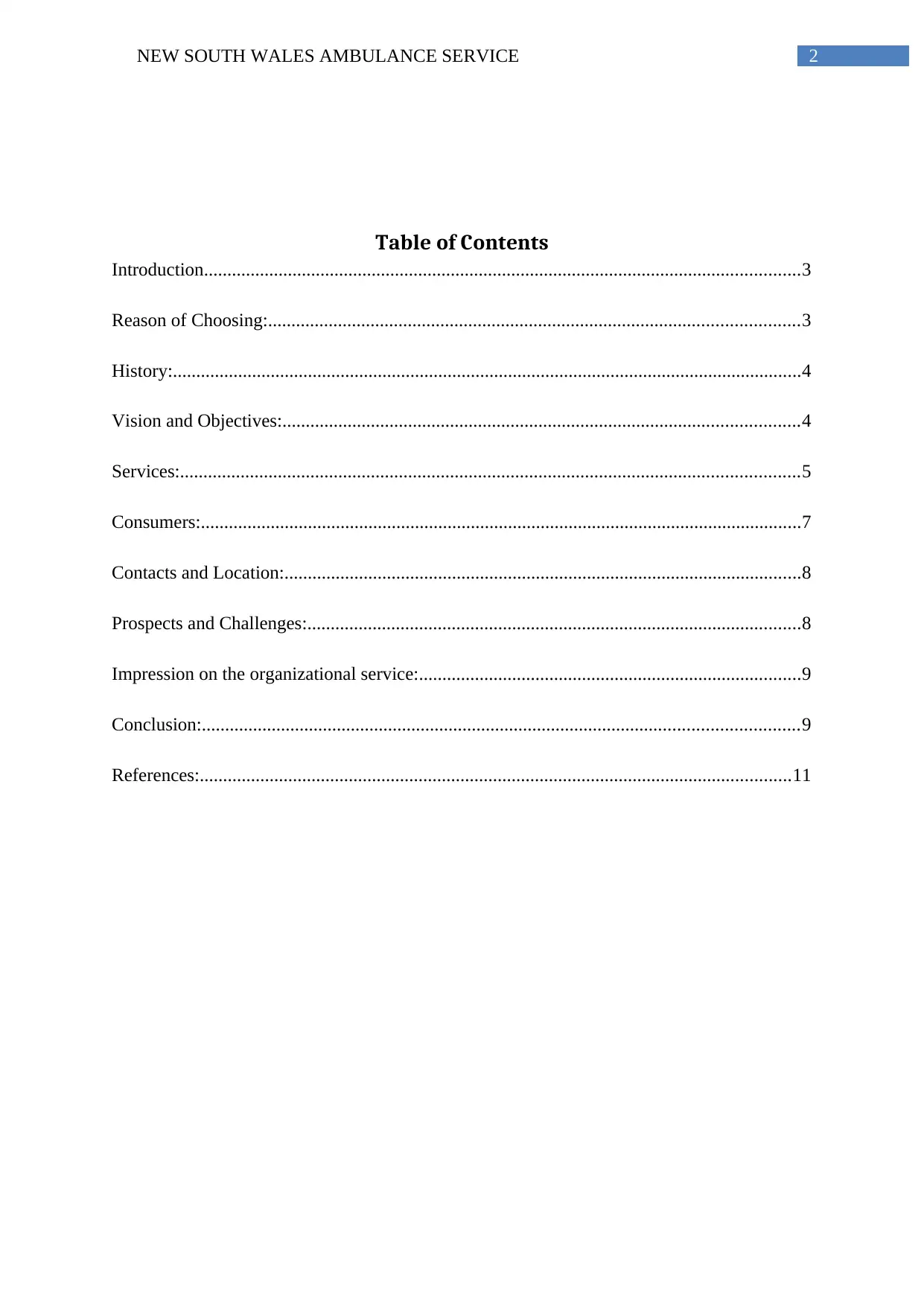
2NEW SOUTH WALES AMBULANCE SERVICE
Table of Contents
Introduction................................................................................................................................3
Reason of Choosing:..................................................................................................................3
History:.......................................................................................................................................4
Vision and Objectives:...............................................................................................................4
Services:.....................................................................................................................................5
Consumers:.................................................................................................................................7
Contacts and Location:...............................................................................................................8
Prospects and Challenges:..........................................................................................................8
Impression on the organizational service:..................................................................................9
Conclusion:................................................................................................................................9
References:...............................................................................................................................11
Table of Contents
Introduction................................................................................................................................3
Reason of Choosing:..................................................................................................................3
History:.......................................................................................................................................4
Vision and Objectives:...............................................................................................................4
Services:.....................................................................................................................................5
Consumers:.................................................................................................................................7
Contacts and Location:...............................................................................................................8
Prospects and Challenges:..........................................................................................................8
Impression on the organizational service:..................................................................................9
Conclusion:................................................................................................................................9
References:...............................................................................................................................11
⊘ This is a preview!⊘
Do you want full access?
Subscribe today to unlock all pages.

Trusted by 1+ million students worldwide
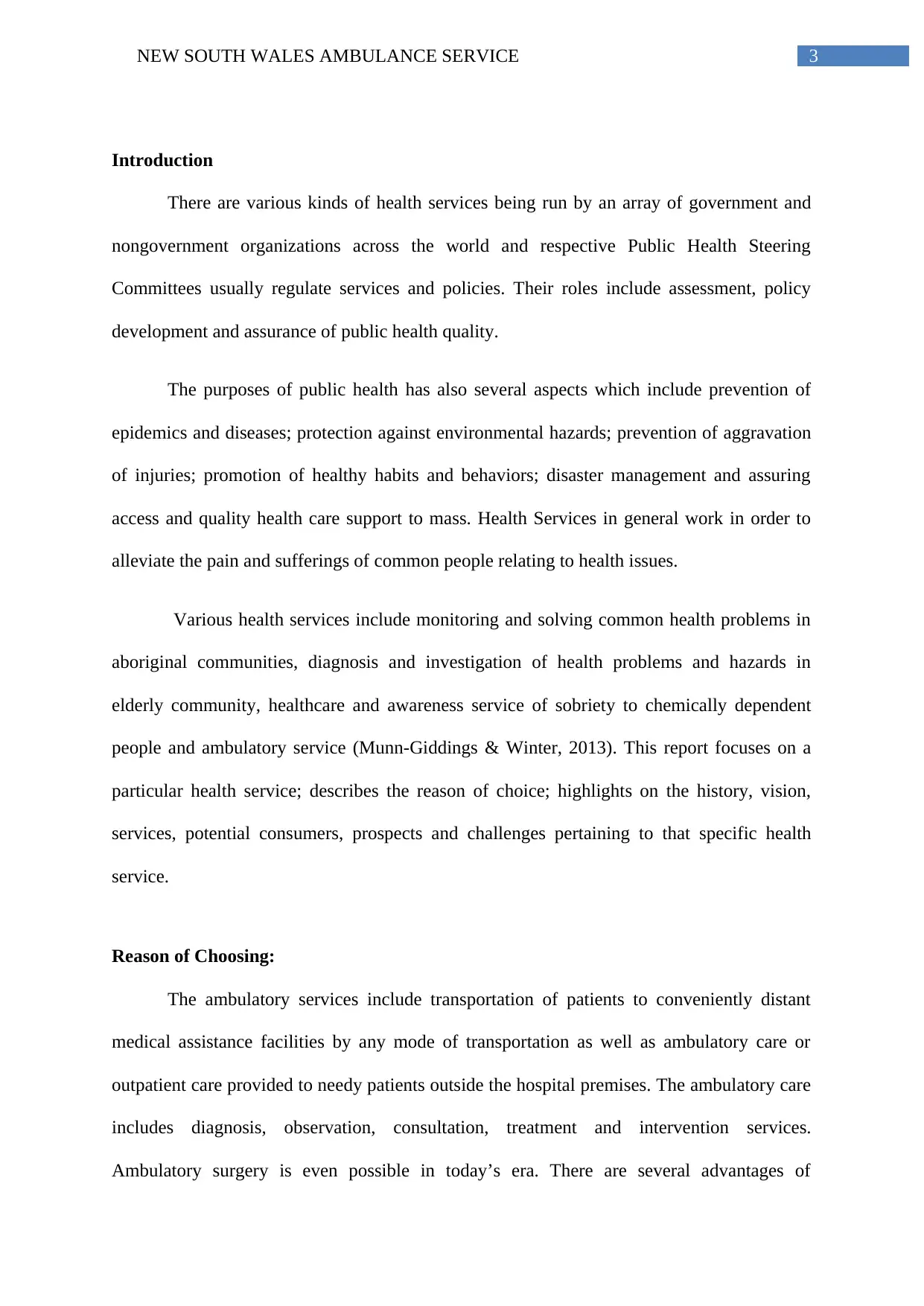
3NEW SOUTH WALES AMBULANCE SERVICE
Introduction
There are various kinds of health services being run by an array of government and
nongovernment organizations across the world and respective Public Health Steering
Committees usually regulate services and policies. Their roles include assessment, policy
development and assurance of public health quality.
The purposes of public health has also several aspects which include prevention of
epidemics and diseases; protection against environmental hazards; prevention of aggravation
of injuries; promotion of healthy habits and behaviors; disaster management and assuring
access and quality health care support to mass. Health Services in general work in order to
alleviate the pain and sufferings of common people relating to health issues.
Various health services include monitoring and solving common health problems in
aboriginal communities, diagnosis and investigation of health problems and hazards in
elderly community, healthcare and awareness service of sobriety to chemically dependent
people and ambulatory service (Munn-Giddings & Winter, 2013). This report focuses on a
particular health service; describes the reason of choice; highlights on the history, vision,
services, potential consumers, prospects and challenges pertaining to that specific health
service.
Reason of Choosing:
The ambulatory services include transportation of patients to conveniently distant
medical assistance facilities by any mode of transportation as well as ambulatory care or
outpatient care provided to needy patients outside the hospital premises. The ambulatory care
includes diagnosis, observation, consultation, treatment and intervention services.
Ambulatory surgery is even possible in today’s era. There are several advantages of
Introduction
There are various kinds of health services being run by an array of government and
nongovernment organizations across the world and respective Public Health Steering
Committees usually regulate services and policies. Their roles include assessment, policy
development and assurance of public health quality.
The purposes of public health has also several aspects which include prevention of
epidemics and diseases; protection against environmental hazards; prevention of aggravation
of injuries; promotion of healthy habits and behaviors; disaster management and assuring
access and quality health care support to mass. Health Services in general work in order to
alleviate the pain and sufferings of common people relating to health issues.
Various health services include monitoring and solving common health problems in
aboriginal communities, diagnosis and investigation of health problems and hazards in
elderly community, healthcare and awareness service of sobriety to chemically dependent
people and ambulatory service (Munn-Giddings & Winter, 2013). This report focuses on a
particular health service; describes the reason of choice; highlights on the history, vision,
services, potential consumers, prospects and challenges pertaining to that specific health
service.
Reason of Choosing:
The ambulatory services include transportation of patients to conveniently distant
medical assistance facilities by any mode of transportation as well as ambulatory care or
outpatient care provided to needy patients outside the hospital premises. The ambulatory care
includes diagnosis, observation, consultation, treatment and intervention services.
Ambulatory surgery is even possible in today’s era. There are several advantages of
Paraphrase This Document
Need a fresh take? Get an instant paraphrase of this document with our AI Paraphraser
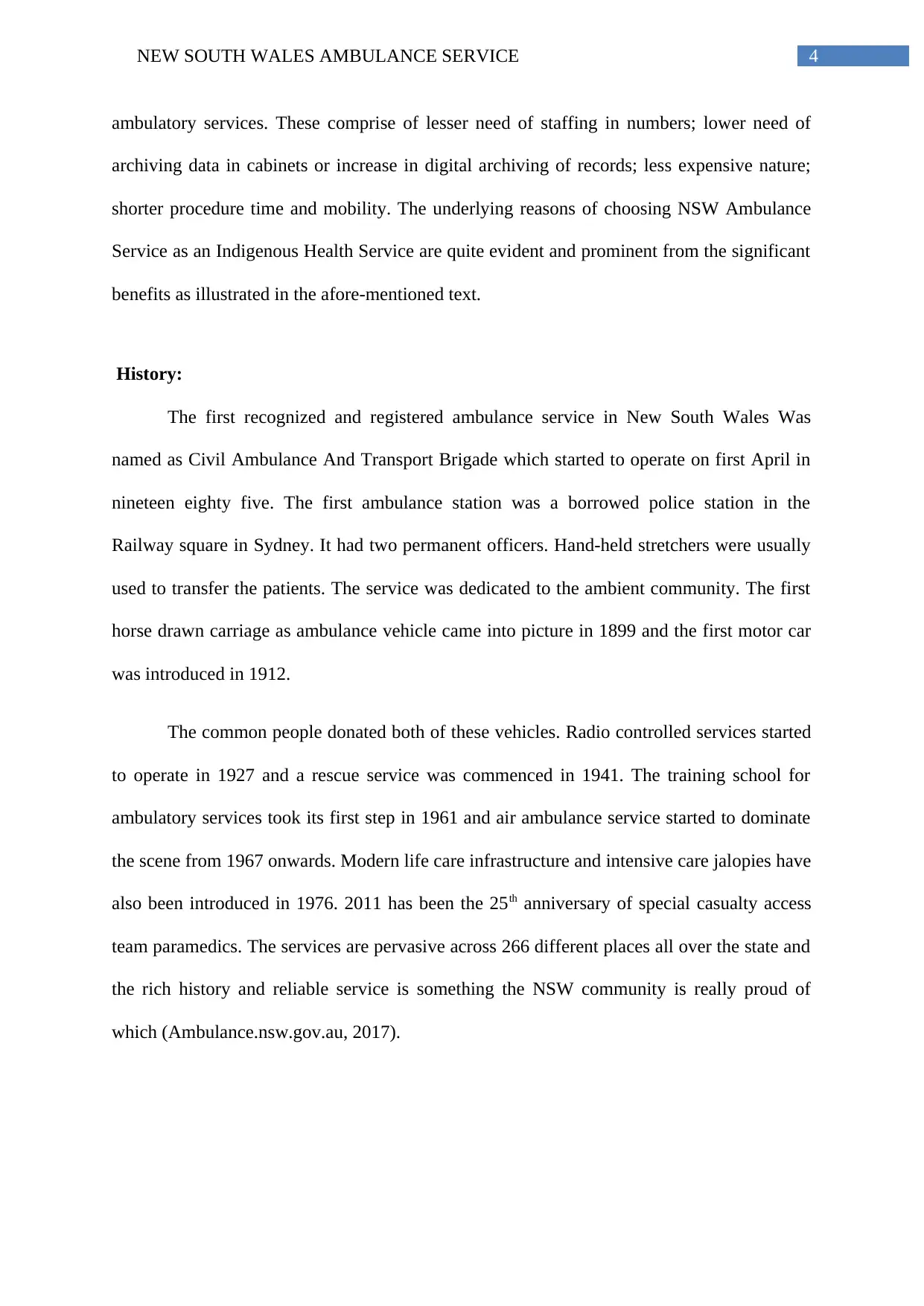
4NEW SOUTH WALES AMBULANCE SERVICE
ambulatory services. These comprise of lesser need of staffing in numbers; lower need of
archiving data in cabinets or increase in digital archiving of records; less expensive nature;
shorter procedure time and mobility. The underlying reasons of choosing NSW Ambulance
Service as an Indigenous Health Service are quite evident and prominent from the significant
benefits as illustrated in the afore-mentioned text.
History:
The first recognized and registered ambulance service in New South Wales Was
named as Civil Ambulance And Transport Brigade which started to operate on first April in
nineteen eighty five. The first ambulance station was a borrowed police station in the
Railway square in Sydney. It had two permanent officers. Hand-held stretchers were usually
used to transfer the patients. The service was dedicated to the ambient community. The first
horse drawn carriage as ambulance vehicle came into picture in 1899 and the first motor car
was introduced in 1912.
The common people donated both of these vehicles. Radio controlled services started
to operate in 1927 and a rescue service was commenced in 1941. The training school for
ambulatory services took its first step in 1961 and air ambulance service started to dominate
the scene from 1967 onwards. Modern life care infrastructure and intensive care jalopies have
also been introduced in 1976. 2011 has been the 25th anniversary of special casualty access
team paramedics. The services are pervasive across 266 different places all over the state and
the rich history and reliable service is something the NSW community is really proud of
which (Ambulance.nsw.gov.au, 2017).
ambulatory services. These comprise of lesser need of staffing in numbers; lower need of
archiving data in cabinets or increase in digital archiving of records; less expensive nature;
shorter procedure time and mobility. The underlying reasons of choosing NSW Ambulance
Service as an Indigenous Health Service are quite evident and prominent from the significant
benefits as illustrated in the afore-mentioned text.
History:
The first recognized and registered ambulance service in New South Wales Was
named as Civil Ambulance And Transport Brigade which started to operate on first April in
nineteen eighty five. The first ambulance station was a borrowed police station in the
Railway square in Sydney. It had two permanent officers. Hand-held stretchers were usually
used to transfer the patients. The service was dedicated to the ambient community. The first
horse drawn carriage as ambulance vehicle came into picture in 1899 and the first motor car
was introduced in 1912.
The common people donated both of these vehicles. Radio controlled services started
to operate in 1927 and a rescue service was commenced in 1941. The training school for
ambulatory services took its first step in 1961 and air ambulance service started to dominate
the scene from 1967 onwards. Modern life care infrastructure and intensive care jalopies have
also been introduced in 1976. 2011 has been the 25th anniversary of special casualty access
team paramedics. The services are pervasive across 266 different places all over the state and
the rich history and reliable service is something the NSW community is really proud of
which (Ambulance.nsw.gov.au, 2017).
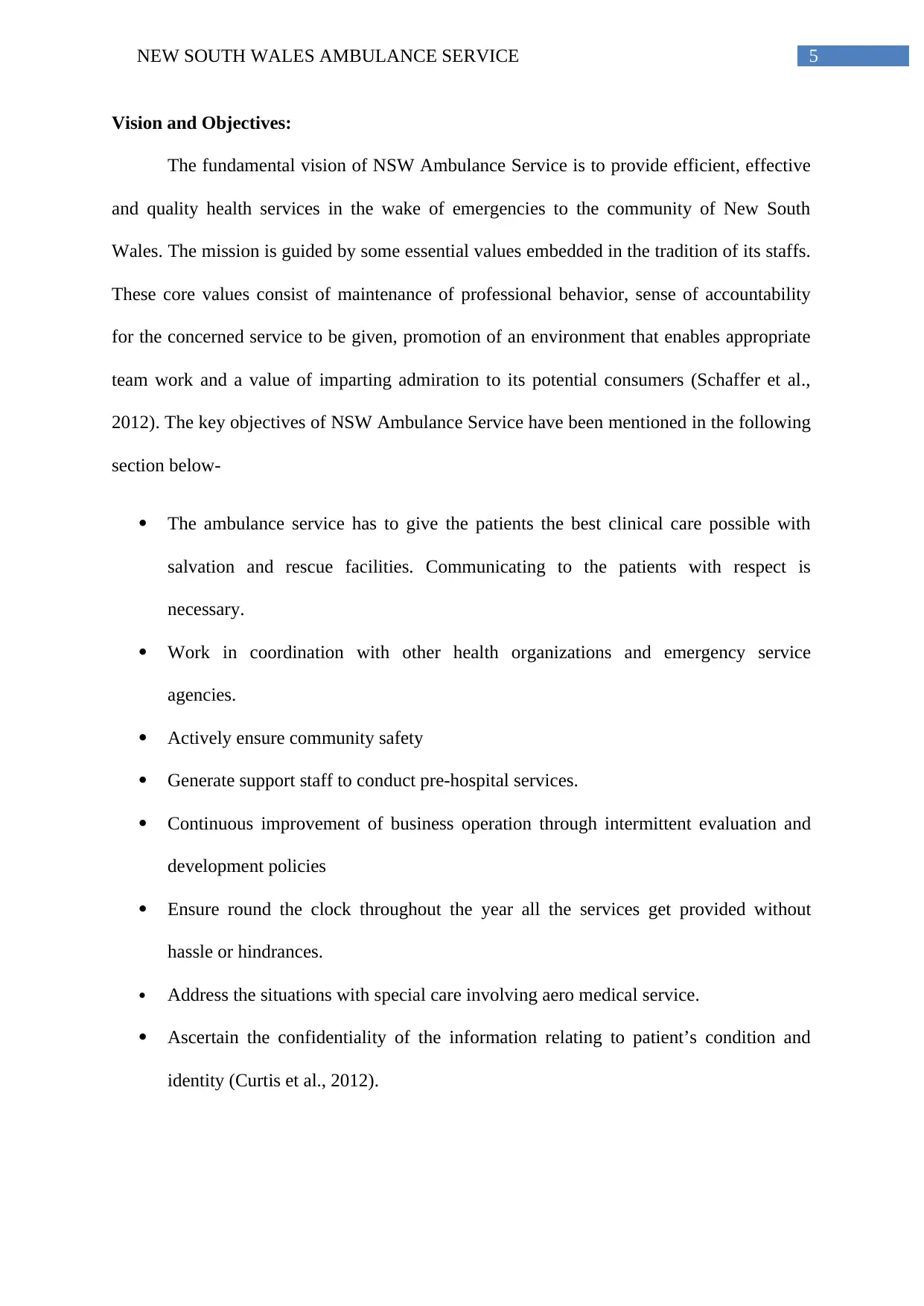
5NEW SOUTH WALES AMBULANCE SERVICE
Vision and Objectives:
The fundamental vision of NSW Ambulance Service is to provide efficient, effective
and quality health services in the wake of emergencies to the community of New South
Wales. The mission is guided by some essential values embedded in the tradition of its staffs.
These core values consist of maintenance of professional behavior, sense of accountability
for the concerned service to be given, promotion of an environment that enables appropriate
team work and a value of imparting admiration to its potential consumers (Schaffer et al.,
2012). The key objectives of NSW Ambulance Service have been mentioned in the following
section below-
The ambulance service has to give the patients the best clinical care possible with
salvation and rescue facilities. Communicating to the patients with respect is
necessary.
Work in coordination with other health organizations and emergency service
agencies.
Actively ensure community safety
Generate support staff to conduct pre-hospital services.
Continuous improvement of business operation through intermittent evaluation and
development policies
Ensure round the clock throughout the year all the services get provided without
hassle or hindrances.
Address the situations with special care involving aero medical service.
Ascertain the confidentiality of the information relating to patient’s condition and
identity (Curtis et al., 2012).
Vision and Objectives:
The fundamental vision of NSW Ambulance Service is to provide efficient, effective
and quality health services in the wake of emergencies to the community of New South
Wales. The mission is guided by some essential values embedded in the tradition of its staffs.
These core values consist of maintenance of professional behavior, sense of accountability
for the concerned service to be given, promotion of an environment that enables appropriate
team work and a value of imparting admiration to its potential consumers (Schaffer et al.,
2012). The key objectives of NSW Ambulance Service have been mentioned in the following
section below-
The ambulance service has to give the patients the best clinical care possible with
salvation and rescue facilities. Communicating to the patients with respect is
necessary.
Work in coordination with other health organizations and emergency service
agencies.
Actively ensure community safety
Generate support staff to conduct pre-hospital services.
Continuous improvement of business operation through intermittent evaluation and
development policies
Ensure round the clock throughout the year all the services get provided without
hassle or hindrances.
Address the situations with special care involving aero medical service.
Ascertain the confidentiality of the information relating to patient’s condition and
identity (Curtis et al., 2012).
⊘ This is a preview!⊘
Do you want full access?
Subscribe today to unlock all pages.

Trusted by 1+ million students worldwide
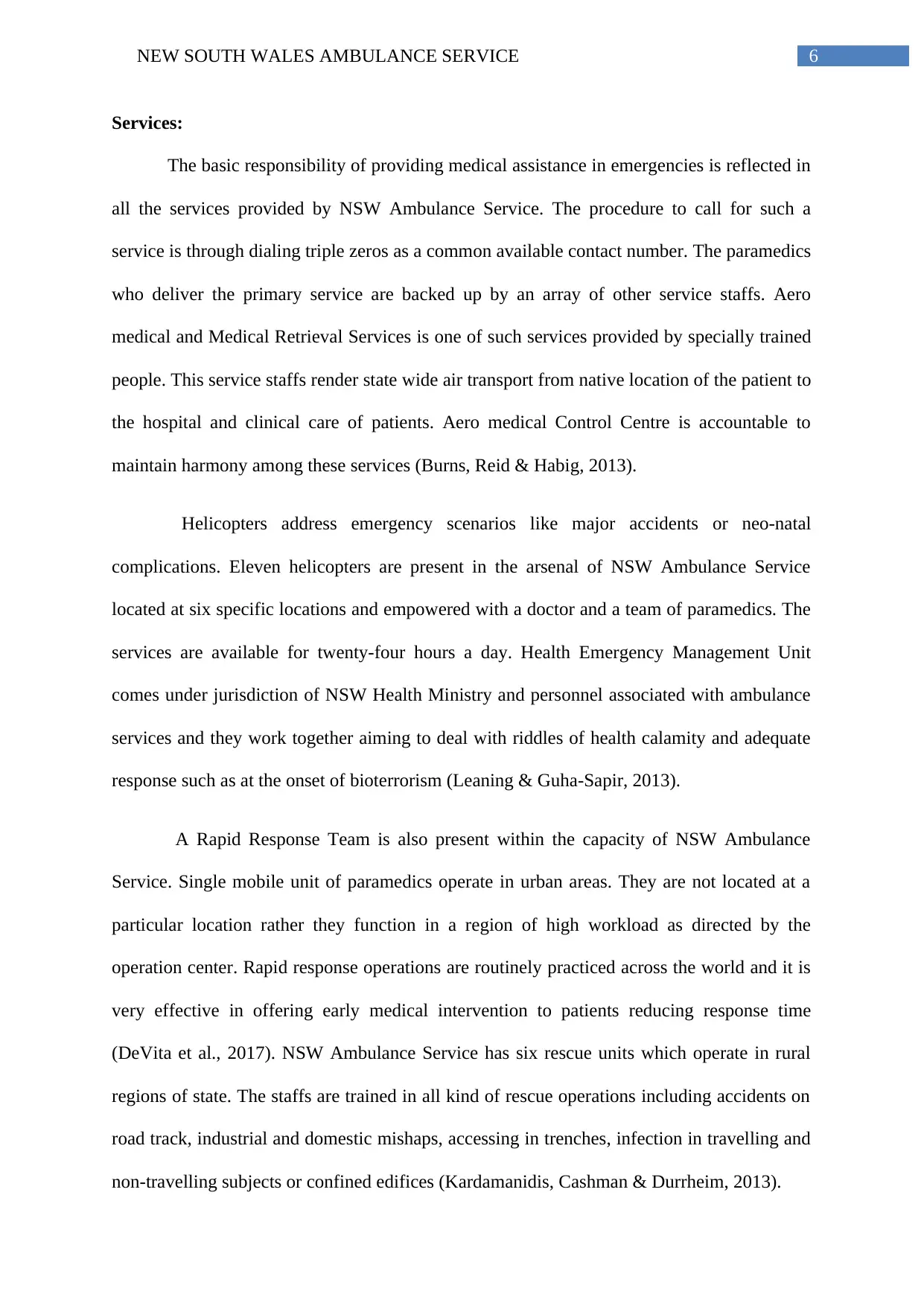
6NEW SOUTH WALES AMBULANCE SERVICE
Services:
The basic responsibility of providing medical assistance in emergencies is reflected in
all the services provided by NSW Ambulance Service. The procedure to call for such a
service is through dialing triple zeros as a common available contact number. The paramedics
who deliver the primary service are backed up by an array of other service staffs. Aero
medical and Medical Retrieval Services is one of such services provided by specially trained
people. This service staffs render state wide air transport from native location of the patient to
the hospital and clinical care of patients. Aero medical Control Centre is accountable to
maintain harmony among these services (Burns, Reid & Habig, 2013).
Helicopters address emergency scenarios like major accidents or neo-natal
complications. Eleven helicopters are present in the arsenal of NSW Ambulance Service
located at six specific locations and empowered with a doctor and a team of paramedics. The
services are available for twenty-four hours a day. Health Emergency Management Unit
comes under jurisdiction of NSW Health Ministry and personnel associated with ambulance
services and they work together aiming to deal with riddles of health calamity and adequate
response such as at the onset of bioterrorism (Leaning & Guha-Sapir, 2013).
A Rapid Response Team is also present within the capacity of NSW Ambulance
Service. Single mobile unit of paramedics operate in urban areas. They are not located at a
particular location rather they function in a region of high workload as directed by the
operation center. Rapid response operations are routinely practiced across the world and it is
very effective in offering early medical intervention to patients reducing response time
(DeVita et al., 2017). NSW Ambulance Service has six rescue units which operate in rural
regions of state. The staffs are trained in all kind of rescue operations including accidents on
road track, industrial and domestic mishaps, accessing in trenches, infection in travelling and
non-travelling subjects or confined edifices (Kardamanidis, Cashman & Durrheim, 2013).
Services:
The basic responsibility of providing medical assistance in emergencies is reflected in
all the services provided by NSW Ambulance Service. The procedure to call for such a
service is through dialing triple zeros as a common available contact number. The paramedics
who deliver the primary service are backed up by an array of other service staffs. Aero
medical and Medical Retrieval Services is one of such services provided by specially trained
people. This service staffs render state wide air transport from native location of the patient to
the hospital and clinical care of patients. Aero medical Control Centre is accountable to
maintain harmony among these services (Burns, Reid & Habig, 2013).
Helicopters address emergency scenarios like major accidents or neo-natal
complications. Eleven helicopters are present in the arsenal of NSW Ambulance Service
located at six specific locations and empowered with a doctor and a team of paramedics. The
services are available for twenty-four hours a day. Health Emergency Management Unit
comes under jurisdiction of NSW Health Ministry and personnel associated with ambulance
services and they work together aiming to deal with riddles of health calamity and adequate
response such as at the onset of bioterrorism (Leaning & Guha-Sapir, 2013).
A Rapid Response Team is also present within the capacity of NSW Ambulance
Service. Single mobile unit of paramedics operate in urban areas. They are not located at a
particular location rather they function in a region of high workload as directed by the
operation center. Rapid response operations are routinely practiced across the world and it is
very effective in offering early medical intervention to patients reducing response time
(DeVita et al., 2017). NSW Ambulance Service has six rescue units which operate in rural
regions of state. The staffs are trained in all kind of rescue operations including accidents on
road track, industrial and domestic mishaps, accessing in trenches, infection in travelling and
non-travelling subjects or confined edifices (Kardamanidis, Cashman & Durrheim, 2013).
Paraphrase This Document
Need a fresh take? Get an instant paraphrase of this document with our AI Paraphraser
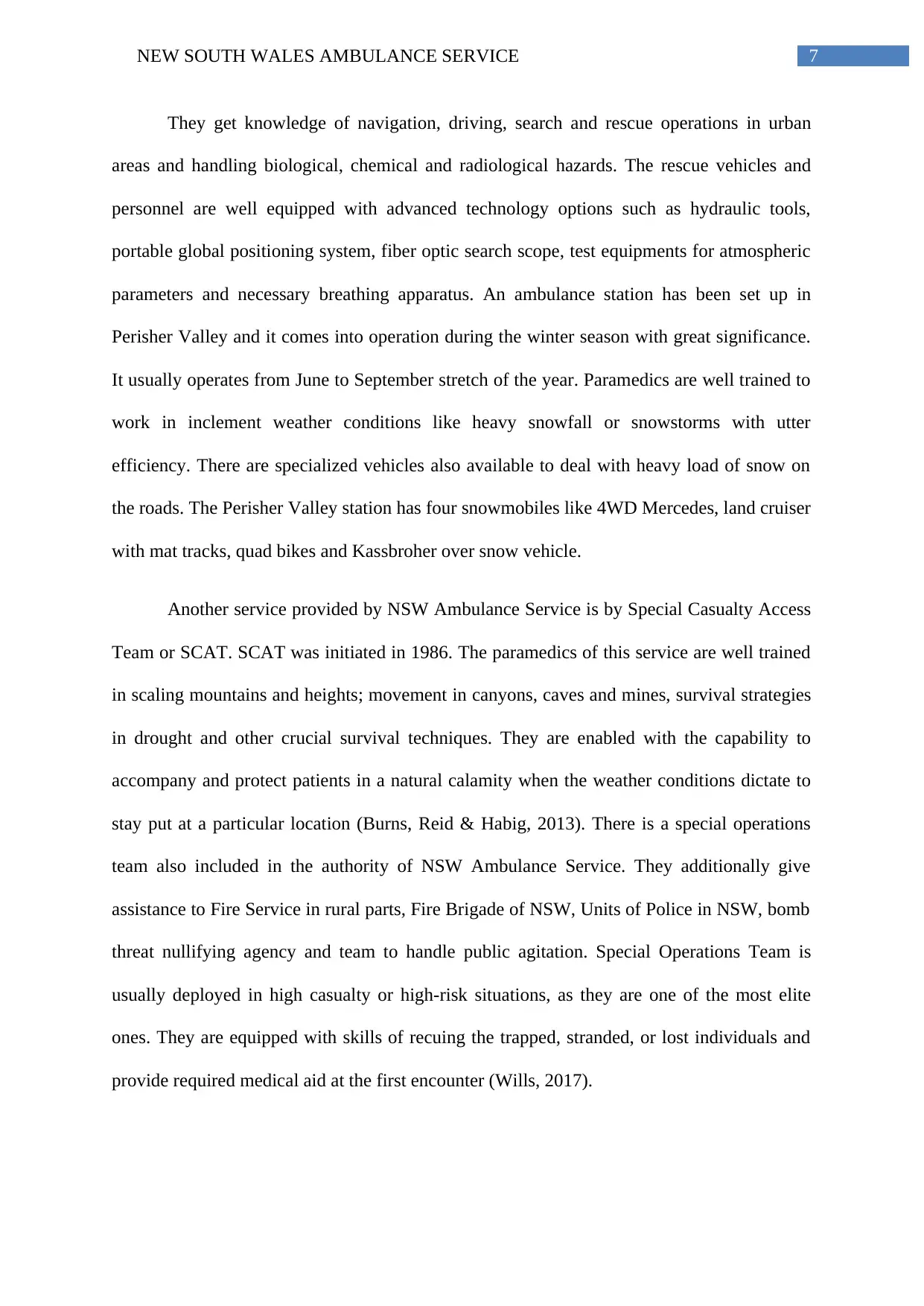
7NEW SOUTH WALES AMBULANCE SERVICE
They get knowledge of navigation, driving, search and rescue operations in urban
areas and handling biological, chemical and radiological hazards. The rescue vehicles and
personnel are well equipped with advanced technology options such as hydraulic tools,
portable global positioning system, fiber optic search scope, test equipments for atmospheric
parameters and necessary breathing apparatus. An ambulance station has been set up in
Perisher Valley and it comes into operation during the winter season with great significance.
It usually operates from June to September stretch of the year. Paramedics are well trained to
work in inclement weather conditions like heavy snowfall or snowstorms with utter
efficiency. There are specialized vehicles also available to deal with heavy load of snow on
the roads. The Perisher Valley station has four snowmobiles like 4WD Mercedes, land cruiser
with mat tracks, quad bikes and Kassbroher over snow vehicle.
Another service provided by NSW Ambulance Service is by Special Casualty Access
Team or SCAT. SCAT was initiated in 1986. The paramedics of this service are well trained
in scaling mountains and heights; movement in canyons, caves and mines, survival strategies
in drought and other crucial survival techniques. They are enabled with the capability to
accompany and protect patients in a natural calamity when the weather conditions dictate to
stay put at a particular location (Burns, Reid & Habig, 2013). There is a special operations
team also included in the authority of NSW Ambulance Service. They additionally give
assistance to Fire Service in rural parts, Fire Brigade of NSW, Units of Police in NSW, bomb
threat nullifying agency and team to handle public agitation. Special Operations Team is
usually deployed in high casualty or high-risk situations, as they are one of the most elite
ones. They are equipped with skills of recuing the trapped, stranded, or lost individuals and
provide required medical aid at the first encounter (Wills, 2017).
They get knowledge of navigation, driving, search and rescue operations in urban
areas and handling biological, chemical and radiological hazards. The rescue vehicles and
personnel are well equipped with advanced technology options such as hydraulic tools,
portable global positioning system, fiber optic search scope, test equipments for atmospheric
parameters and necessary breathing apparatus. An ambulance station has been set up in
Perisher Valley and it comes into operation during the winter season with great significance.
It usually operates from June to September stretch of the year. Paramedics are well trained to
work in inclement weather conditions like heavy snowfall or snowstorms with utter
efficiency. There are specialized vehicles also available to deal with heavy load of snow on
the roads. The Perisher Valley station has four snowmobiles like 4WD Mercedes, land cruiser
with mat tracks, quad bikes and Kassbroher over snow vehicle.
Another service provided by NSW Ambulance Service is by Special Casualty Access
Team or SCAT. SCAT was initiated in 1986. The paramedics of this service are well trained
in scaling mountains and heights; movement in canyons, caves and mines, survival strategies
in drought and other crucial survival techniques. They are enabled with the capability to
accompany and protect patients in a natural calamity when the weather conditions dictate to
stay put at a particular location (Burns, Reid & Habig, 2013). There is a special operations
team also included in the authority of NSW Ambulance Service. They additionally give
assistance to Fire Service in rural parts, Fire Brigade of NSW, Units of Police in NSW, bomb
threat nullifying agency and team to handle public agitation. Special Operations Team is
usually deployed in high casualty or high-risk situations, as they are one of the most elite
ones. They are equipped with skills of recuing the trapped, stranded, or lost individuals and
provide required medical aid at the first encounter (Wills, 2017).
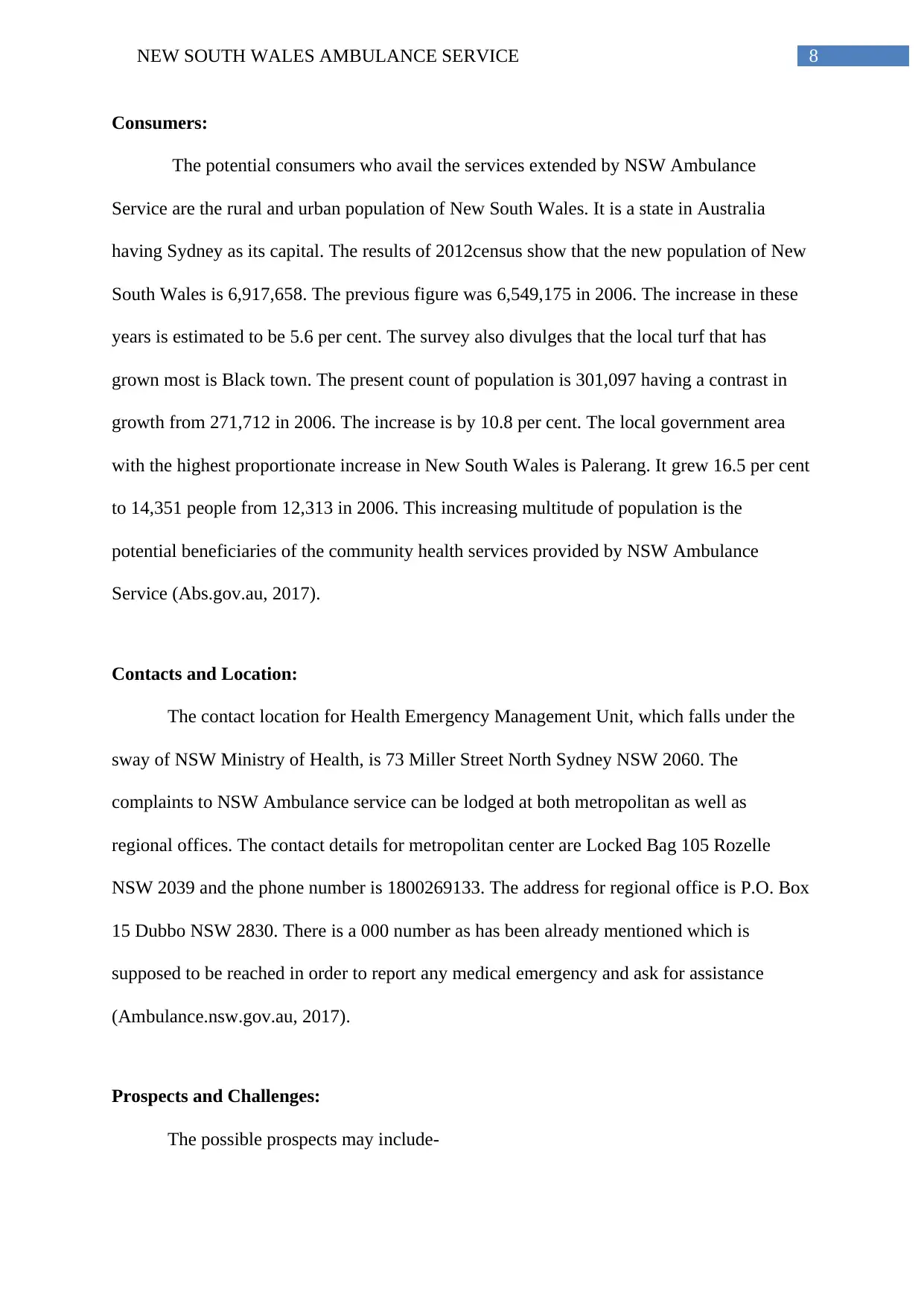
8NEW SOUTH WALES AMBULANCE SERVICE
Consumers:
The potential consumers who avail the services extended by NSW Ambulance
Service are the rural and urban population of New South Wales. It is a state in Australia
having Sydney as its capital. The results of 2012census show that the new population of New
South Wales is 6,917,658. The previous figure was 6,549,175 in 2006. The increase in these
years is estimated to be 5.6 per cent. The survey also divulges that the local turf that has
grown most is Black town. The present count of population is 301,097 having a contrast in
growth from 271,712 in 2006. The increase is by 10.8 per cent. The local government area
with the highest proportionate increase in New South Wales is Palerang. It grew 16.5 per cent
to 14,351 people from 12,313 in 2006. This increasing multitude of population is the
potential beneficiaries of the community health services provided by NSW Ambulance
Service (Abs.gov.au, 2017).
Contacts and Location:
The contact location for Health Emergency Management Unit, which falls under the
sway of NSW Ministry of Health, is 73 Miller Street North Sydney NSW 2060. The
complaints to NSW Ambulance service can be lodged at both metropolitan as well as
regional offices. The contact details for metropolitan center are Locked Bag 105 Rozelle
NSW 2039 and the phone number is 1800269133. The address for regional office is P.O. Box
15 Dubbo NSW 2830. There is a 000 number as has been already mentioned which is
supposed to be reached in order to report any medical emergency and ask for assistance
(Ambulance.nsw.gov.au, 2017).
Prospects and Challenges:
The possible prospects may include-
Consumers:
The potential consumers who avail the services extended by NSW Ambulance
Service are the rural and urban population of New South Wales. It is a state in Australia
having Sydney as its capital. The results of 2012census show that the new population of New
South Wales is 6,917,658. The previous figure was 6,549,175 in 2006. The increase in these
years is estimated to be 5.6 per cent. The survey also divulges that the local turf that has
grown most is Black town. The present count of population is 301,097 having a contrast in
growth from 271,712 in 2006. The increase is by 10.8 per cent. The local government area
with the highest proportionate increase in New South Wales is Palerang. It grew 16.5 per cent
to 14,351 people from 12,313 in 2006. This increasing multitude of population is the
potential beneficiaries of the community health services provided by NSW Ambulance
Service (Abs.gov.au, 2017).
Contacts and Location:
The contact location for Health Emergency Management Unit, which falls under the
sway of NSW Ministry of Health, is 73 Miller Street North Sydney NSW 2060. The
complaints to NSW Ambulance service can be lodged at both metropolitan as well as
regional offices. The contact details for metropolitan center are Locked Bag 105 Rozelle
NSW 2039 and the phone number is 1800269133. The address for regional office is P.O. Box
15 Dubbo NSW 2830. There is a 000 number as has been already mentioned which is
supposed to be reached in order to report any medical emergency and ask for assistance
(Ambulance.nsw.gov.au, 2017).
Prospects and Challenges:
The possible prospects may include-
⊘ This is a preview!⊘
Do you want full access?
Subscribe today to unlock all pages.

Trusted by 1+ million students worldwide
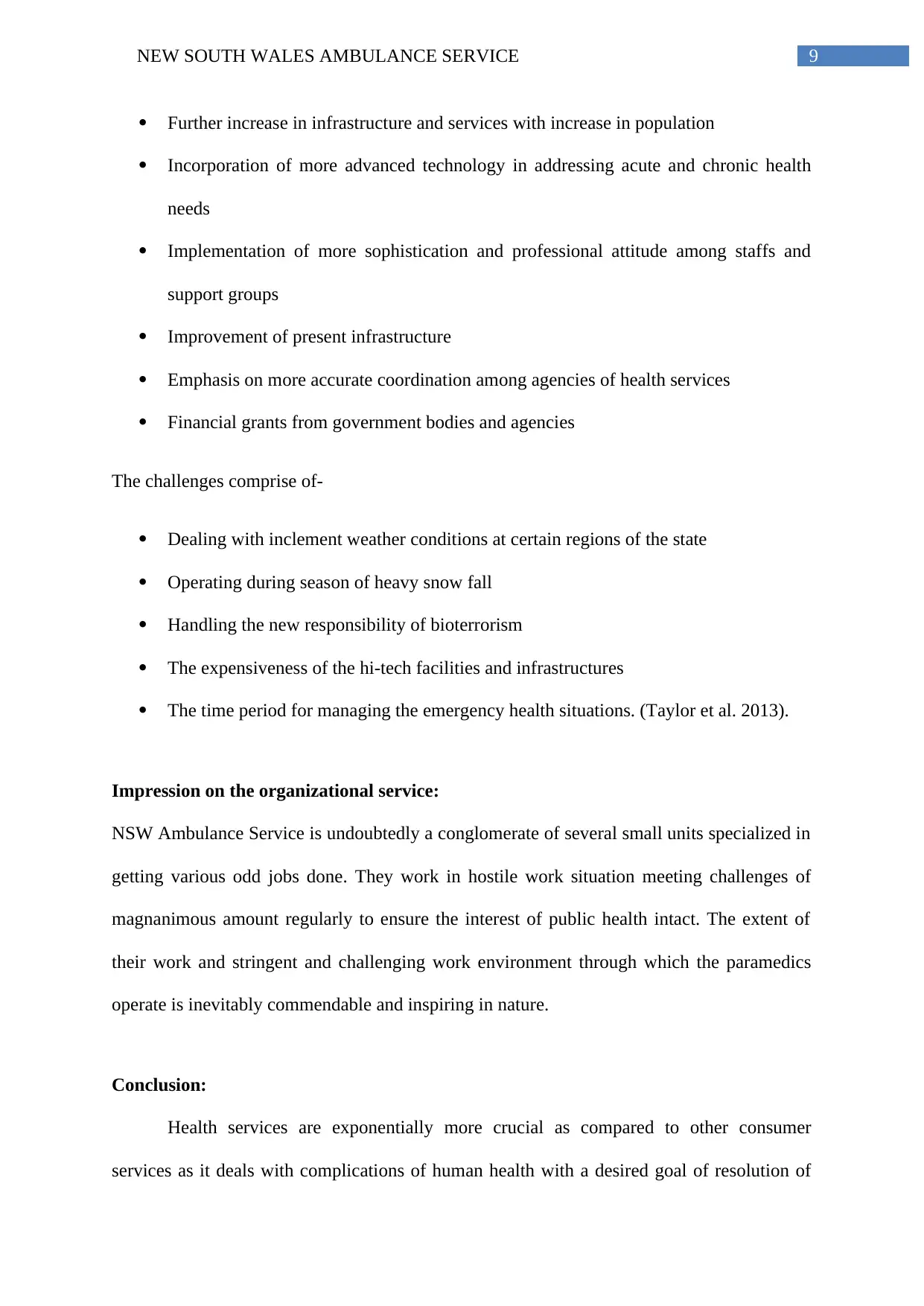
9NEW SOUTH WALES AMBULANCE SERVICE
Further increase in infrastructure and services with increase in population
Incorporation of more advanced technology in addressing acute and chronic health
needs
Implementation of more sophistication and professional attitude among staffs and
support groups
Improvement of present infrastructure
Emphasis on more accurate coordination among agencies of health services
Financial grants from government bodies and agencies
The challenges comprise of-
Dealing with inclement weather conditions at certain regions of the state
Operating during season of heavy snow fall
Handling the new responsibility of bioterrorism
The expensiveness of the hi-tech facilities and infrastructures
The time period for managing the emergency health situations. (Taylor et al. 2013).
Impression on the organizational service:
NSW Ambulance Service is undoubtedly a conglomerate of several small units specialized in
getting various odd jobs done. They work in hostile work situation meeting challenges of
magnanimous amount regularly to ensure the interest of public health intact. The extent of
their work and stringent and challenging work environment through which the paramedics
operate is inevitably commendable and inspiring in nature.
Conclusion:
Health services are exponentially more crucial as compared to other consumer
services as it deals with complications of human health with a desired goal of resolution of
Further increase in infrastructure and services with increase in population
Incorporation of more advanced technology in addressing acute and chronic health
needs
Implementation of more sophistication and professional attitude among staffs and
support groups
Improvement of present infrastructure
Emphasis on more accurate coordination among agencies of health services
Financial grants from government bodies and agencies
The challenges comprise of-
Dealing with inclement weather conditions at certain regions of the state
Operating during season of heavy snow fall
Handling the new responsibility of bioterrorism
The expensiveness of the hi-tech facilities and infrastructures
The time period for managing the emergency health situations. (Taylor et al. 2013).
Impression on the organizational service:
NSW Ambulance Service is undoubtedly a conglomerate of several small units specialized in
getting various odd jobs done. They work in hostile work situation meeting challenges of
magnanimous amount regularly to ensure the interest of public health intact. The extent of
their work and stringent and challenging work environment through which the paramedics
operate is inevitably commendable and inspiring in nature.
Conclusion:
Health services are exponentially more crucial as compared to other consumer
services as it deals with complications of human health with a desired goal of resolution of
Paraphrase This Document
Need a fresh take? Get an instant paraphrase of this document with our AI Paraphraser

10NEW SOUTH WALES AMBULANCE SERVICE
those conditions and problems. Health Service personnel face various specific and general
obstacles depending on the nature of the service in which focus has been given considering
NSW Ambulance Service as a unit model. A detailed analysis suggests proper state support
and government funds along with private capital in constant manner is indispensable for
hassle free service and up gradation in regard of the same in this domain of health care.
those conditions and problems. Health Service personnel face various specific and general
obstacles depending on the nature of the service in which focus has been given considering
NSW Ambulance Service as a unit model. A detailed analysis suggests proper state support
and government funds along with private capital in constant manner is indispensable for
hassle free service and up gradation in regard of the same in this domain of health care.
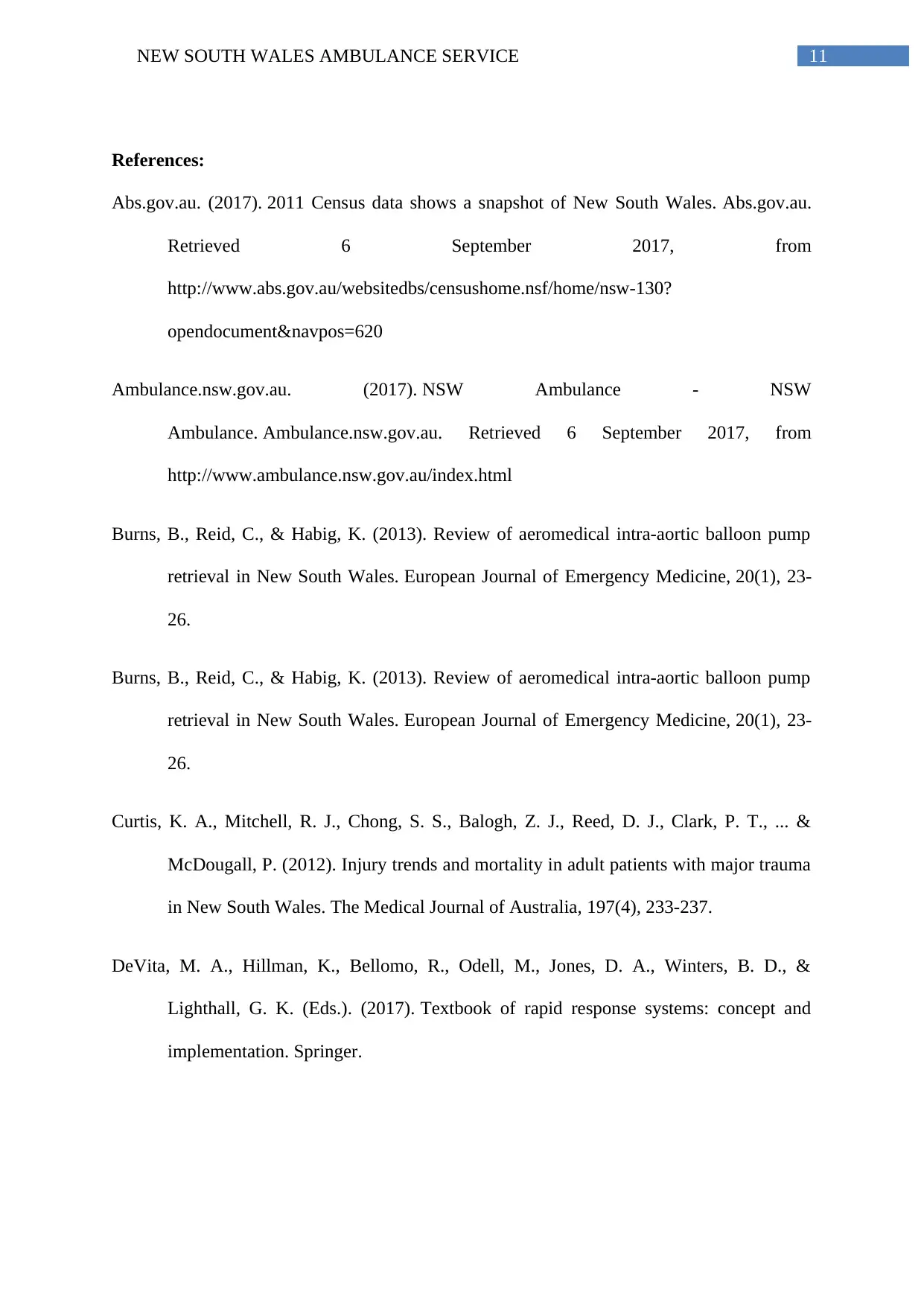
11NEW SOUTH WALES AMBULANCE SERVICE
References:
Abs.gov.au. (2017). 2011 Census data shows a snapshot of New South Wales. Abs.gov.au.
Retrieved 6 September 2017, from
http://www.abs.gov.au/websitedbs/censushome.nsf/home/nsw-130?
opendocument&navpos=620
Ambulance.nsw.gov.au. (2017). NSW Ambulance - NSW
Ambulance. Ambulance.nsw.gov.au. Retrieved 6 September 2017, from
http://www.ambulance.nsw.gov.au/index.html
Burns, B., Reid, C., & Habig, K. (2013). Review of aeromedical intra-aortic balloon pump
retrieval in New South Wales. European Journal of Emergency Medicine, 20(1), 23-
26.
Burns, B., Reid, C., & Habig, K. (2013). Review of aeromedical intra-aortic balloon pump
retrieval in New South Wales. European Journal of Emergency Medicine, 20(1), 23-
26.
Curtis, K. A., Mitchell, R. J., Chong, S. S., Balogh, Z. J., Reed, D. J., Clark, P. T., ... &
McDougall, P. (2012). Injury trends and mortality in adult patients with major trauma
in New South Wales. The Medical Journal of Australia, 197(4), 233-237.
DeVita, M. A., Hillman, K., Bellomo, R., Odell, M., Jones, D. A., Winters, B. D., &
Lighthall, G. K. (Eds.). (2017). Textbook of rapid response systems: concept and
implementation. Springer.
References:
Abs.gov.au. (2017). 2011 Census data shows a snapshot of New South Wales. Abs.gov.au.
Retrieved 6 September 2017, from
http://www.abs.gov.au/websitedbs/censushome.nsf/home/nsw-130?
opendocument&navpos=620
Ambulance.nsw.gov.au. (2017). NSW Ambulance - NSW
Ambulance. Ambulance.nsw.gov.au. Retrieved 6 September 2017, from
http://www.ambulance.nsw.gov.au/index.html
Burns, B., Reid, C., & Habig, K. (2013). Review of aeromedical intra-aortic balloon pump
retrieval in New South Wales. European Journal of Emergency Medicine, 20(1), 23-
26.
Burns, B., Reid, C., & Habig, K. (2013). Review of aeromedical intra-aortic balloon pump
retrieval in New South Wales. European Journal of Emergency Medicine, 20(1), 23-
26.
Curtis, K. A., Mitchell, R. J., Chong, S. S., Balogh, Z. J., Reed, D. J., Clark, P. T., ... &
McDougall, P. (2012). Injury trends and mortality in adult patients with major trauma
in New South Wales. The Medical Journal of Australia, 197(4), 233-237.
DeVita, M. A., Hillman, K., Bellomo, R., Odell, M., Jones, D. A., Winters, B. D., &
Lighthall, G. K. (Eds.). (2017). Textbook of rapid response systems: concept and
implementation. Springer.
⊘ This is a preview!⊘
Do you want full access?
Subscribe today to unlock all pages.

Trusted by 1+ million students worldwide
1 out of 14
Your All-in-One AI-Powered Toolkit for Academic Success.
+13062052269
info@desklib.com
Available 24*7 on WhatsApp / Email
![[object Object]](/_next/static/media/star-bottom.7253800d.svg)
Unlock your academic potential
Copyright © 2020–2025 A2Z Services. All Rights Reserved. Developed and managed by ZUCOL.


